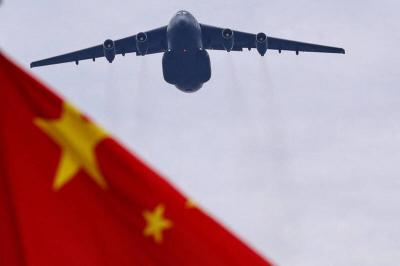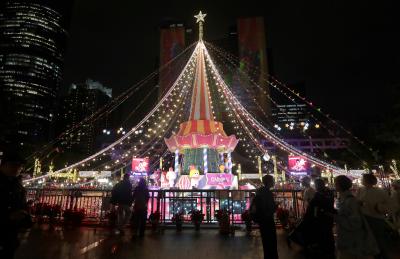Phoenix, the nation’s first solar-powered unmanned aerial vehicle (UAV), successfully made its first test flight in Taipei yesterday, showing off the results of three years of research and development by a team from the Department of Aerospace Engineering of Tamkang University.
The aircraft, which weighs about 9.3kg, has solar arrays (a group of solar panels) attached to its wings that are 3.7m long and cover 65 percent of the wing surface. The solar panels, which operate at 18 percent efficiency, cannot produce sufficient energy to power the drone, so two lithium polymer batteries provide the remaining energy needed to keep the aircraft aloft.
Phoenix has not yet been able to store solar energy in fuel cells for use at night.

Photo: Tsai Pai-ling, Taipei Times, courtesy of Tamkang University’s Department of Aerospace Engineering
“The most difficult part of the project is to design and build a system that utilizes as well as maximizes energy,” said Ma Te-ming (馬德明), an associate professor at the department. “We have developed our own software to achieve the best efficiency possible.”
Ma also said Phoenix could harvest all its power from the sun if solar panels that operate at 30 percent efficiency are used. However, the limited funding provided by the university and the National Science Council means that the researchers need to make the most with what funding they have.
“A 3x7cm panel that is 30 percent efficient costs NT$10,000. We can’t afford it. The total amount we spent on solar panels is around NT$30,000,” he said. “The total cost of the drone is around NT$100,000.”
Composed of about 30 students from two aerial engineering laboratories amd led by three academics, including Ma, the university’s team made a couple of test models before Phoenix.
“My job is to develop the solar energy system. It took forever to set up the system. After it was set up, we spent another year running tests,” 25-year-old team member Liang Chun-kang (梁淳剛) said.
Under the midday sun at the His Sheng Remote Control Aircraft Park in New Taipei City’s (新北市) Sinjhuang (新莊) yesterday, the UAV took off on an airstrip as the research team piloted it by remote control. It flew at an average speed of 34km per hour, circled in the sky a few times and made a slightly rough landing that caused minor damage to one of its tires.
The range of the remote control is one to two kilometers, Ma said, adding the aircraft’s slow velocity renders it vulnerable to crosswinds.
The test flight is expected to provide valuable data relating to battery voltage, electric current, flight height, aircraft motions for further development.
The ultimate goal, Ma said, is to make an entirely solar-powered aircraft, with solar panels feeding on batteries that can keep the craft aloft at night or in the rain.
One of the main reasons for developing solar-powered UAVs is to extend aircraft flight times because they can use the sun as an unlimited source of energy, Ma said.
“Because UAVs don’t need human pilots, we want to keep them up in the air as long as possible to carry out operations considered too dangerous for manned aircraft,” he added.
UAVs have a wide range of uses and mission capabilities beyond military purposes. For example, they can be used for search-and-rescue operations, monitoring drug trafficking and detecting pollution, Ma said.

Beijing could eventually see a full amphibious invasion of Taiwan as the only "prudent" way to bring about unification, the US Department of Defense said in a newly released annual report to Congress. The Pentagon's "Annual Report to Congress: Military and Security Developments Involving the People's Republic of China 2025," was in many ways similar to last year’s report but reorganized the analysis of the options China has to take over Taiwan. Generally, according to the report, Chinese leaders view the People's Liberation Army's (PLA) capabilities for a Taiwan campaign as improving, but they remain uncertain about its readiness to successfully seize

Taiwan is getting a day off on Christmas for the first time in 25 years. The change comes after opposition parties passed a law earlier this year to add or restore five public holidays, including Constitution Day, which falls on today, Dec. 25. The day marks the 1947 adoption of the constitution of the Republic of China, as the government in Taipei is formally known. Back then the Chinese Nationalist Party (KMT) governed China from Nanjing. When the KMT, now an opposition party in Taiwan, passed the legislation on holidays, it said that they would help “commemorate the history of national development.” That

Taiwan has overtaken South Korea this year in per capita income for the first time in 23 years, IMF data showed. Per capita income is a nation’s GDP divided by the total population, used to compare average wealth levels across countries. Taiwan also beat Japan this year on per capita income, after surpassing it for the first time last year, US magazine Newsweek reported yesterday. Across Asia, Taiwan ranked fourth for per capita income at US$37,827 this year due to sustained economic growth, the report said. In the top three spots were Singapore, Macau and Hong Kong, it said. South

Snow fell on Yushan (Jade Mountain, 玉山) yesterday morning as a continental cold air mass sent temperatures below freezing on Taiwan’s tallest peak, the Central Weather Administration (CWA) said. Snowflakes were seen on Yushan’s north peak from 6:28am to 6:38am, but they did not fully cover the ground and no accumulation was recorded, the CWA said. As of 7:42am, the lowest temperature recorded across Taiwan was minus-5.5°C at Yushan’s Fengkou observatory and minus-4.7°C at the Yushan observatory, CWA data showed. On Hehuanshan (合歡山) in Nantou County, a low of 1.3°C was recorded at 6:39pm, when ice pellets fell at Songsyue Lodge (松雪樓), a